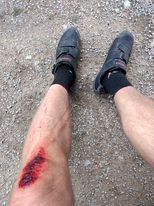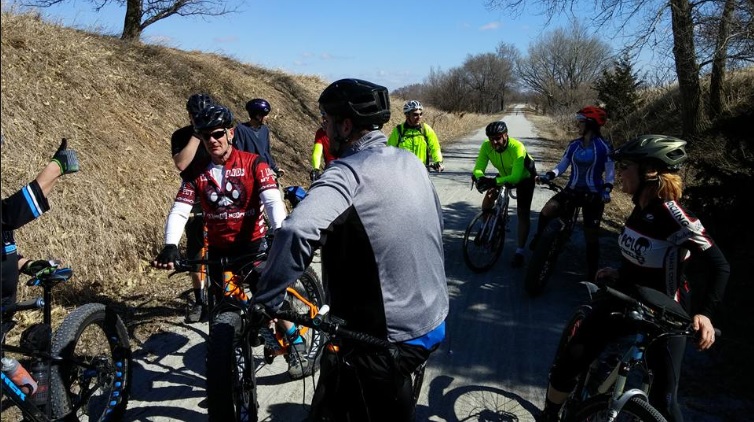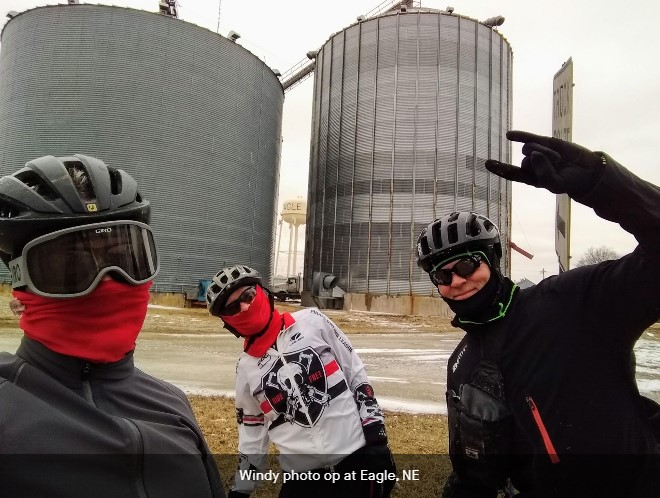I’ve written about the wind before, but it’s been an issue this spring, as it always is on the Great Plains. On that windy weekend before last, I know that a few cyclists out riding gravel came home bloodied. No one seems to know exactly what happened, but I have my suspicions. They had recently changed direction, going from a slow slog into a headwind to a tailwind, with a little crosswind thrown in. I wonder if the wind, instead of holding them down, caught them off-guard with the changing conditions and lifted their wheels enough to lay them down.

The last time I talked about the wind I was thinking of my friend who broke his collarbone, taken down by a gust from a crosswind. He had a front rack with a basket containing a few provisions, and he felt like the handlebars were torn from his hands and wrenched sideways. The gusts that day were probably 40 mph. So what do you do if you still want to ride outside? I’ve included a couple of links below to give you some solid tips. They range from riding in the trees to wearing clothes that won’t “parachute” i.e. tight fitting. Also, keep your body and center of gravity low to the bike. A windy day is not a good day for a backpack, as it can become a sail. Be prepared for gaps in windbreaks such as a row of buildings that can surprise the unwary. Of course, it’s going to be a better plan to check the wind direction and speed beforehand. You’ll probably want to ride out with more of the headwind, and back with more of the tailwind. Also, remember the saying “spin into the wind.” A couple of years ago I messed up my knee powering back home into 20 miles of headwind on a longer commuting ride that I had no choice of the direction for. I was on a trail in the trees, but it wasn’t enough. It took five months for my knee to get back to it’s less-than-perfect self. My error was in trying to power through it, rather than spin at a higher cadence.

One bit of advice I’ve heard, about riding in the drops of the drop bars, has caught my attention. While it is preferable when cornering or going into the wind to be as low as possible on the bike, most women, I would venture, cannot both ride in the drops and reach the brakes at the same time. I have large hands for a woman, I can wear a men’s extra small glove, but me being able to reach the brakes while in the drops is laughable. To use the brakes my hands have to be on the hoods, which keeps me out the drops if anything sketchy that I’d want to use my brakes for, like steep descents or maybe even wind, is happening. And I ride a “women specific” bike, even.
Here are the links:
https://www.welovecycling.com/wide/2019/04/03/essential-tips-on-riding-in-the-wind/ is good for some basics.
The following tips are from:
https://www.cyclescheme.co.uk/community/how-to/how-to-ride-when-the-wind-blows “A powerful enough crosswind can push any cyclist. Aside from your own strength and mass, the only thing keeping you in place is the traction of your bike’s tyres on the tarmac. Take special care whenever there’s less traction available – when leaning into a turn, for example, or when riding over a slippery surface such as rain-slick white lines. Wider, softer tyres put more rubber in touch with the road so are less likely to skip sideways.
Bike control in crosswinds is easier with a wide, flat handlebar, as it provides more steering leverage. Unfortunately, a wide flat bar is harder work in headwinds… If you’re using a drop bar, don’t ride on the tops with your hands close together; keep them on the brake hoods or drops so your hands are further apart.
What is Considered Windy, and How Do You Know When It’s Too Windy to Ride a Bike?
There will be occasional days where it’s inadvisable to ride your bike. At the less severe end of the scale, that depends on what you’re comfortable with. A 20mph wind is enough to make small trees sway and is very obvious on a bike. It’s seldom hazardous per se, but if it makes you feel unsafe then leave the bike at home. At 30mph, the wind makes cycling quite difficult, even for the more experienced cyclist.” (Winds in excess of 40 or 50 mph are gales and are best avoided.)

So, like they some Nebraskans say, the wind is our mountains. In the Netherlands they call it “Dutch hills.” If you learn how to ride in it you don’t have to avoid it, but you might need to allow yourself a little more time if your commute involves a head wind.
